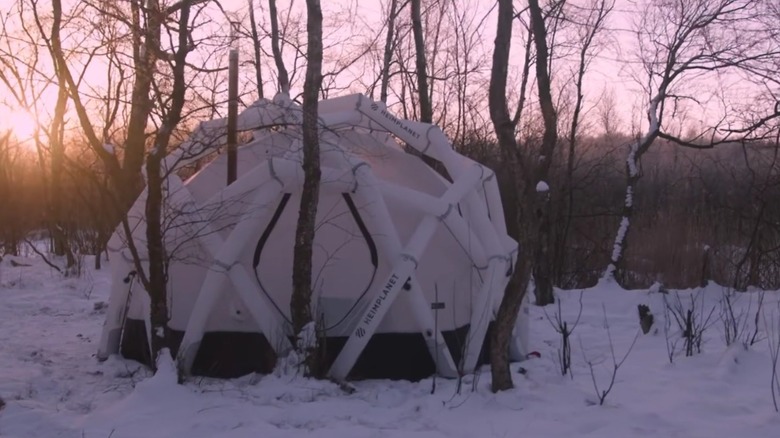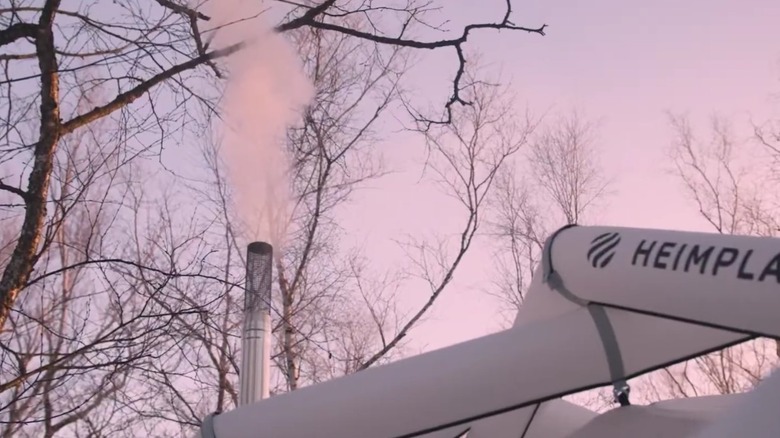This Ultra-Rugged Tent Was Made To Resist Hurricane-Strength Winds – Here's How It Works
Experienced campers armed with the best equipment probably aren't going to be phased by a bit of rain or wind, but even the most dedicated outdoorspeople will sometimes have to concede that it's just not the right conditions for camping. Take a hurricane or hurricane-strength winds, for instance. If conditions like that are bearing down on you, staying in a tent for the weekend in the vicinity is going to potentially be incredibly dangerous and all but impossible from a practical point of view. This isn't to say, though, that there aren't especially resilient tents that are designed especially for extreme conditions.
You might expect a canvas tent to simply be ripped from the pegs binding it to the ground and whipped away into the air in such conditions, and many might. However, there are certain models that are designed to resist so much more. An expedition to a remote region with extreme conditions is going to require something a little more than your average motorcycle camping trip, which is why the likes of the mighty MAVERICKS tent were created. This model, in particular, is described by creator Heimplanet as having a "special geodesic structure is designed for wind speeds of up to 180 km/h." Critically, this doesn't mean that it can withstand any hurricane-force winds. The geodesic structure also plays a vital role in the tent's resistance, as it helps prevent weather damage by distributing the external force acting on the tent equally. This is why geodesic structures are, in a broader sense, so resilient. Here's how hurricane wind strengths are measured, and what this means for the MAVERICK tent's capabilities.
Determining the strength of a hurricane
The Saffir-Simpson Hurricane Scale was devised to contextualize the strength of wind associated with a given hurricane and the level of destruction it's capable of causing. The National Weather Service explains that the scale grades a hurricane from 1 to 5, with 1 being the weakest. In these cases, the hurricane is capable of producing winds of between 119-153 km/h, in the course of which "well-constructed frame homes could have damage to roof, shingles, vinyl siding and gutters. Large branches of trees will snap, and shallowly rooted trees may be toppled." On the other end of the scale are Grade 5 hurricanes, which herald winds of 252 km/h or above. These devastating events are capable of such destruction that "a high percentage of framed homes will be destroyed, with total roof failure and wall collapse."
Needless to say, even the most specialized of tents could not withstand such force, and so the MAVERICKS tent is not created for this purpose. Heimplanet's specified limit of 180 km/h winds pushes it to the very upper limits of a category two hurricane's power (154-177 km/h) and barely into category three (178-208 km/h), making it unsuited to those sorts of extremes. Even so, the tent is designed to be capable of withstanding the effects of certain grades of hurricane-strength winds that would devastate buildings. Among the essential gadgets you might need for storm season, after all, might be a hardy tent.
How a tent can withstand hurricane-force winds
The U.K. Met Office notes that tents are generally intended to be weather-resistant, but winds above 48 km/h can damage them. You might be wondering then how Heimplanet's MAVERICKS tent, which costs approximately $6,685 depending on the model, can withstand such ferocious winds. The key is the model's geodesic design, with a surrounding inflatable framework. Landscape photographer Benjamin Hardman explains in his review that all the tents have "a dual-layer inflation structure on the outside, and the way that this is engineered has a geodesic structure that gives increased strength and wind resistance." Hardman has relied on Heimplanet tents for around a decade of photography in Iceland, amid the foreboding temperatures and challenging landscapes.
A geodesic design evenly holds the strain of the structure throughout its sections and is therefore self-supporting for the most part. This can help to maximize room available within the internal structure, while also, as Hardman explains, standing strong amid the kinds of harsh conditions that could rip poles and pegs out of the ground or otherwise cause considerable damage. It also provides extra protection against the additional dangers that can accompany such gusts, such as extreme rainfall. It capitalizes on the inherent strength of angular sections of a structure: evenly distributing force across a surface to prevent it from overwhelming any particular component. The design of the MAVERICK tent ensures that should any individual section of the exterior structure be compromised or punctured, it can be isolated and repaired separately, allowing the rest of the tent to maintain its integrity as much as possible. While there is some camping gear you should avoid spending your money on, you also should always be prepared for the conditions you'll face.


